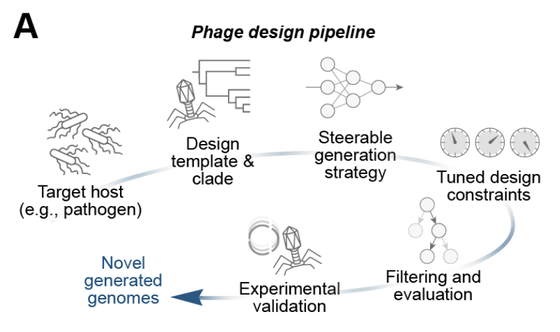World's first successful virus genome design using AI

by
A research team from Stanford University, Memorial Sloan Kettering Cancer Center , and the Arc Institute has announced the world's first design of a bacteriophage genome using a language model. The results of this research have been published on the preprint server bioRxiv.
Generative design of novel bacteriophages with genome language models | bioRxiv
https://www.biorxiv.org/content/10.1101/2025.09.12.675911v1
World's first AI-designed viruses a step towards AI-generated life
https://www.nature.com/articles/d41586-025-03055-y
The genome language model used by the research team is an AI model that treats DNA, RNA, and protein sequences as a 'language' and learns their grammar and meaning. The genome language model treats DNA base sequences like words in a sentence, and by reading a huge amount of genome sequence data, it learns the 'grammar' that forms the basis of life activities, such as which genes have what functions and how genes interact with each other.
The models used in this study, 'Evo 1' and 'Evo 2,' were pre-trained on a very large dataset containing over 2 million genomes of viruses, including bacteriophages. The research team further trained this pre-trained model on approximately 15,000 genomes of single-stranded bacteriophages from the Microviridae family. This enabled Evo 1 and Evo 2 to design viruses with specific functions with even greater accuracy.
The team then evaluated thousands of genome sequences generated by AI and narrowed the list to 302 candidates. They synthesized DNA from these designs, introduced them into host bacteria, and generated phages. After further testing, they created 16 viable phages.

Below is an electron microscope image of a phage actually designed by AI.

Below is a 3D model of the phage structure constructed by computer processing based on the above photograph.

Some of the phages generated showed higher growth fitness and faster lysis kinetics than wild-type phages. Furthermore, when the generated phages were mixed together, they successfully inhibited the growth of three drug-resistant E. coli strains that could not be killed by wild-type phages. The research team suggests that the diverse phages generated by AI may be effective in overcoming evolving bacterial resistance.
The research team concluded that their findings demonstrate that generative AI can capture the evolutionary design space underlying the genome, the blueprint of life, and create novel, functioning bacteriophage genomes.
While previous AI designs have focused on single genes and proteins, this research is the first to successfully design an entire genome, where multiple genes and regulatory regions interact in complex ways. The research team believes that this achievement paves the way for the design of more complex biological systems, and envisions the generation of larger genomes in the future. However, designing the genomes of larger phages and organisms requires challenges, such as the cost of DNA synthesis and assembly, and further innovation in methods.
Furthermore, improving AI genome design capabilities requires important biosafety considerations. While the research team emphasized that this study was conducted in a safe model system, future work on human pathogens and other pathogens should be conducted with careful deliberation by the scientific community and in accordance with all applicable regulations.
Related Posts:
in Free Member, AI, Science, Posted by log1i_yk







